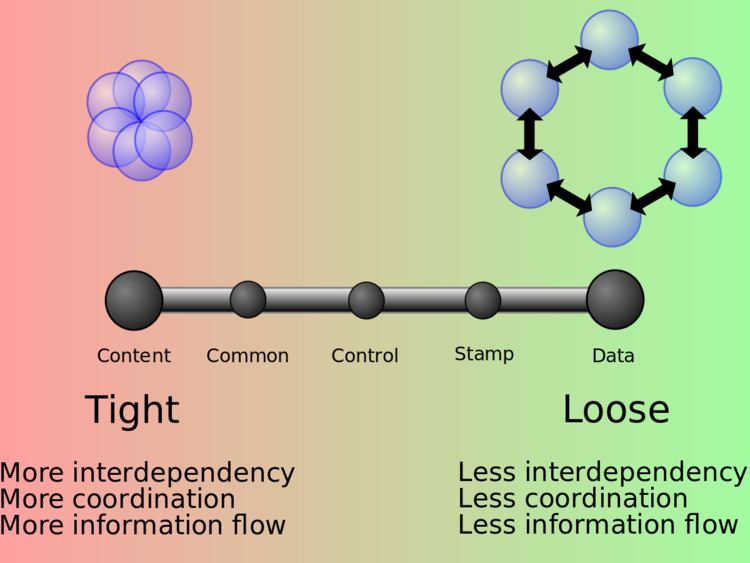 | ||
In software engineering, coupling is the degree of interdependence between software modules; a measure of how closely connected two routines or modules are; the strength of the relationships between modules.
Contents
- History
- Types of coupling
- Procedural programming
- Object oriented programming
- Disadvantages
- Performance issues
- Solutions
- Coupling versus cohesion
- Module coupling
- References
Coupling is usually contrasted with cohesion. Low coupling often correlates with high cohesion, and vice versa. Low coupling is often a sign of a well-structured computer system and a good design, and when combined with high cohesion, supports the general goals of high readability and maintainability.
History
The software quality metrics of coupling and cohesion were invented by Larry Constantine in the late 1960s as part of Structured Design, based on characteristics of “good” programming practices that reduced maintenance and modification costs. Structured Design, including cohesion and coupling, were published in the article Stevens, Myers & Constantine (1974) and the book Yourdon & Constantine (1979), and the latter subsequently became standard terms.
Types of coupling
Coupling can be "low" (also "loose" and "weak") or "high" (also "tight" and "strong"). Some types of coupling, in order of highest to lowest coupling, are as follows:
Procedural programming
A module here refers to a subroutine of any kind, i.e. a set of one or more statements having a name and preferably its own set of variable names.
Object-oriented programming
In recent work various other coupling concepts have been investigated and used as indicators for different modularization principles used in practice.
Disadvantages
Tightly coupled systems tend to exhibit the following developmental characteristics, which are often seen as disadvantages:
- A change in one module usually forces a ripple effect of changes in other modules.
- Assembly of modules might require more effort and/or time due to the increased inter-module dependency.
- A particular module might be harder to reuse and/or test because dependent modules must be included.
Performance issues
Whether loosely or tightly coupled, a system's performance is often reduced by message and parameter creation, transmission, translation (e.g. marshaling) and message interpretation (which might be a reference to a string, array or data structure), which require less overhead than creating a complicated message such as a SOAP message. Longer messages require more CPU and memory to produce. To optimize runtime performance, message length must be minimized and message meaning must be maximized.
Solutions
One approach to decreasing coupling is functional design, which seeks to limit the responsibilities of modules along functionality. Coupling increases between two classes A and B if:
Low coupling refers to a relationship in which one module interacts with another module through a simple and stable interface and does not need to be concerned with the other module's internal implementation (see Information Hiding).
Systems such as CORBA or COM allow objects to communicate with each other without having to know anything about the other object's implementation. Both of these systems even allow for objects to communicate with objects written in other languages.
Coupling versus cohesion
Coupling and cohesion are terms which occur together very frequently. Coupling refers to the interdependencies between modules, while cohesion describes how related the functions within a single module are. Low cohesion implies that a given module performs tasks which are not very related to each other and hence can create problems as the module becomes large.
Module coupling
Coupling in Software Engineering describes a version of metrics associated with this concept.
For data and control flow coupling:
For global coupling:
For environmental coupling:
Coupling(C) makes the value larger the more coupled the module is. This number ranges from approximately 0.67 (low coupling) to 1.0 (highly coupled)
For example, if a module has only a single input and output data parameter
If a module has 5 input and output data parameters, an equal number of control parameters, and accesses 10 items of global data, with a fan-in of 3 and a fan-out of 4,
